Home › Forums › The Colonial Era › Dennis Cronin’s School near Kingsbridge – 1766
- This topic has 9 replies, 4 voices, and was last updated 1 year, 9 months ago by
Peter Ostrander.
-
AuthorPosts
-
-
July 10, 2022 at 7:34 pm #2884
The Reverend William Tieck, first president of the Kingsbridge Historical Society, wrote a book about a French Huguenot minister named John Peter Tetard, who opened a French-language school in Kingsbridge before the American Revolution. It was always thought to be the first school in the area. But in the time since Tieck was writing, digitization of documents and the internet have made archives more accessible and research easier. Googling around I found another school from the late colonial period in our neighborhood mentioned in the below document:
 It reads: “Entry of Scholars at Dennis Cronin’s School near Kingsbridge april monday the 7th 1766.” It goes on to name several pupils with last names that have a history in the area like Bussing, Vermilye, and Odell. I don’t have the slightest idea where Dennis Cronin’s school could have been located but the names are associated with the Kingsbridge Heights/Fordham area.
It reads: “Entry of Scholars at Dennis Cronin’s School near Kingsbridge april monday the 7th 1766.” It goes on to name several pupils with last names that have a history in the area like Bussing, Vermilye, and Odell. I don’t have the slightest idea where Dennis Cronin’s school could have been located but the names are associated with the Kingsbridge Heights/Fordham area.The document may seem to come from a rather random source – the Annapolis Heritage Society of Nova Scotia. But Dennis Cronin, who operated the school in Kingsbridge, fled our area to live in Nova Scotia after the American Revolution. And he was not alone. Many local inhabitants that were loyal to King George III of Britain during the Revolution ended up in Nova Scotia, which was still a British colony. There you can find a monument/cairn to Westchester Loyalists.
-
July 11, 2022 at 12:18 pm #2885
Nick
Was Mr. Cronin’s name on the deed listing ? I could not find it.
-
July 11, 2022 at 4:26 pm #2886
I tried looking for a property deed as well for Dennis Cronin but I could not turn up anything.
I looked in Westchester County Deeds because The Bronx was part of Westchester at the time and I checked the New York County deeds since “near Kingsbridge” could mean somewhere in Inwood or Marble Hill. The lack of a deed likely means that he did not own the property where his school was located. It could have been leased or housed in another building.
Here’s something interesting: Dennis Cronin apparently also lived in New Rochelle for a while. The Annapolis Heritage Center in Nova Scotia holds a diary of his detailing “time spent in New Rochelle, New York.” That’s a funny coincidence because that means that both John Peter Tetard and Dennis Cronin both operated schools in Kingsbridge and both previously lived in New Rochelle. Maybe they were partners?
-
July 11, 2022 at 6:15 pm #2887
New Rochelle was settled early 1688 by French Huguenots. Not sure what Cronin taught while we know JP Tetard taught French. The names listed on the document for Cronin are family names in the larger area of Kings Bridge at that period. Streets are named for Bussing in today’s East Bronx, Vermilye down in Inwood and Odell in Yonkers. Perhaps Cronin traveled to the homes of the students and not a physical school.
John Peter Tetard was a teacher but also a minister and an Army Chaplin. He farm and house was located approximately south of today’s Fort Independence St. His farm abutted that of Maj. General Richard Montgomery. Tetard was a Chaplin with Montgomery’s army and was with Montgomery when he was killed in 1775 in the attack on Quebec.
-
July 25, 2022 at 8:05 pm #2896
I just found this 250-year-old advertisement so I thought I would post it to this thread about colonial-era schooling in our area. My guess this is the first and last French language boarding school in the neighborhood. They don’t teach “the Doctrine of the Sphere” like they used to! 1772, New York Gazette.
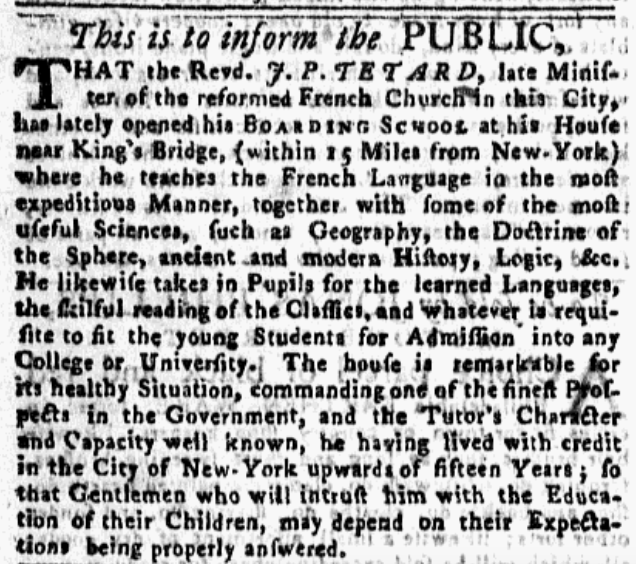
Tetard’s house overlooked the Harlem River from Kingsbridge Heights, hence the sentence about “commanding one of the finest prospects in the Government.”
-
July 25, 2022 at 8:35 pm #2899
Nice Find Nick on Tetard’s school ad !
Tetard’s house is thought to be the former manor house of Jan Archer, the manor of Fordham. It’s thought to have been located south of Fort Independence St along approx Kingsbridge Terrace. Tetard was a neighbor of Gen Richard Montgomery whom he later served as his Chaplin to his Army when it attacked Quebec in 17775 where Montgomery was killed. Tetard’s house was later used for the Hessian General wilhem von Knyphausen before his attack on Ft Washington 1776. It’s been described as s stone block house.
-
July 25, 2022 at 8:54 pm #2900
Thanks. We have a serious advantage over earlier historians with the internet. Being able to search old newspapers is too easy (you can even do it at home and for free if you have a NYPL card). Searching Tetard I found another cool ad that echoes your comment, Peter:
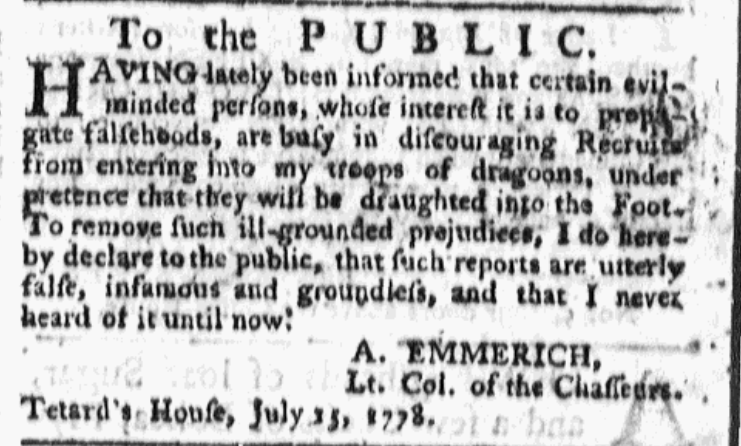
This is ad was placed in the Royal Gazette during the Revolution by Andreas Emmerich, a German mercenary fighting for the British. As you can see, he occupied “Tetard’s House” while Tetard was away in the Continental Army.
-
July 25, 2022 at 10:22 pm #2902
I am new to the site and I am so impressed with the content! I’m really quite fascinated by the amount of German mercenaries ( Emmerich’s Chasseurs) Tory troops (Queens Rangers) there were in the Kingsbridge area. I spent part of my childhood in the Marble Hill and Fort Independence area. As a matter of fact, my bedroom faced Cannon Place and in all likelihood, would have faced the remnants of the old fortification. I was also thrilled to have found an article dated back to 1915, when a group of youths who were trying to build a military trenchline similar to what was in France at that point in time, unearthed a substantial number of cannon balls which were buried at the intersection of Cannon Place and Giles. It’s believed that as the Americans were preparing to abandon the position, the commander of Fort Independence ordered whatever ammunition that they could not take with them to be buried in an effort to keep it out of the hands of British forces. Thank you all for your great research!
Respectfully,
Bob Oles
-
July 26, 2022 at 5:17 pm #2903
Thanks, Bob. It really is amazing how much transpired in our area during the Revolution. It could easily fill a book and maybe someday I will get around to writing it! At the very least it would make a good series of presentations as we approach the 250th anniversary of 1776. Unlike some places that might be famous for a major battle, there was activity in our neighborhood in every year of the war from 1775 to 1783.
And yes, there sure were a lot of Germans stationed here fighting for the British. German was probably the most common spoken language here at times. One German officer John Charles Philip von Krafft was in the local garrison and left a fascinating diary that was translated for the New York Historical Society by a Spuyten Duyvil resident, Thomas Henry Edsall.
-
July 26, 2022 at 6:21 pm #2904
Here are a few maps showing Tetard’s house , Montgomery’s and Fort Independence. The Old Boston Road and Albany Post Roads both started at today’s juncture of W231st and Albany Crescent, basically in front of the old P&K’s, todays’s Bronx Public. The Boston Post Road ran along today’s Albany Crescent, past the Fire House, over Bailey Ave and up the hill turning left on Heath Ave and up around NE to Ft Independence St and Sedgwick Ave. The road today shows the same path as it was back in 1776. The following maps will help show the location of J.P. Tetard’s house.
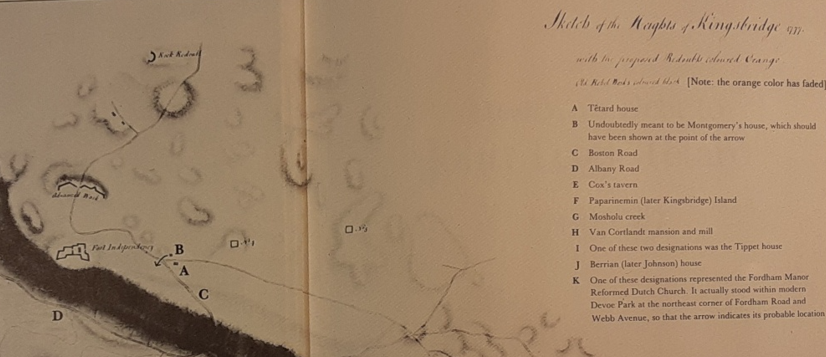
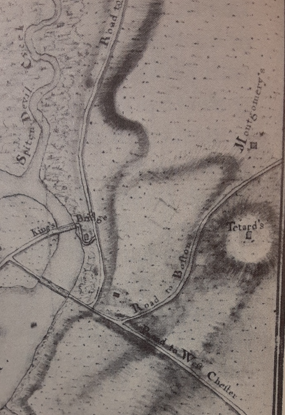
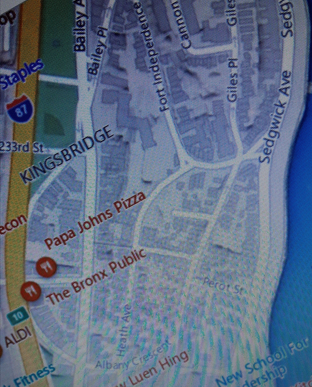
-
-
AuthorPosts
- You must be logged in to reply to this topic.